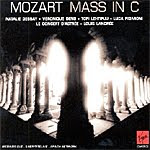 The First and Fourth Symphonies of Gustav Mahler (1860-1911) are his shortest and most-accessible symphonies; moreover, they are today among the most-popular pieces of music ever written. Thus, we would expect a good deal of competition in the marketplace for recordings of them. And such is the case, given the dozens of alternative discs available. I mean, you know it's going to be tough sledding for any newcomer, like this 2010 Capriccio release of the Symphony No. 1 from conductor Christoph Eschenbach, even at its low, budget price.
The First and Fourth Symphonies of Gustav Mahler (1860-1911) are his shortest and most-accessible symphonies; moreover, they are today among the most-popular pieces of music ever written. Thus, we would expect a good deal of competition in the marketplace for recordings of them. And such is the case, given the dozens of alternative discs available. I mean, you know it's going to be tough sledding for any newcomer, like this 2010 Capriccio release of the Symphony No. 1 from conductor Christoph Eschenbach, even at its low, budget price.How well, then, does the Eschenbach entry stack up against budget issues from Barbirolli, Bernstein, Bohm, Davis, de Waart, Judd, Kubelik, Leaper, Maazel, Mehta, Muti, Rattle, Slatkin, Solti, Szell, Wit, Zinman, and a host of others, all of them priced at or below the cost of this Capriccio disc? I'm happy to report it more than holds its own. And it benefits from a new digital recording that is robust, with dead-silent backgrounds.
Under Eschenbach, the symphony's opening moments--all mists and clouds before the sunrise--doesn't carry quite the mystery that, say, Georg Solti's LSO performance does, but Eschenbach never rushes it, and it unfolds pretty well. Here, Nature bursts forth in Her own good time as the sun eventually rises and shines on hill and dale. Mahler said he never intended his symphony to be another pictorial tone poem like those of his contemporary, Richard Strauss, yet comparisons are inevitable, and people have always liked their own literal explanations for the work.
The second movement has a wonderfully bucolic flavor to it, well projected by Eschenbach. In fact, the conductor probably overdoes the country atmosphere, making it too pronounced, too exaggerated. Still, it comes off pleasantly enough.
Mahler's third movement is one of his more bizarre creations, beginning with the familiar "Frere Jacques" tune but proceeding more slowly than usual in keeping with the mood Eschenbach has established for the rest of the performance. Then, the whole orchestra takes up the tune in overlapping style. I always think of this part of the music as representing a rustic Jewish wedding, but afterwards Mahler follows it with a dirgelike funeral march, representative perhaps a huntsman's burial. Even though it's all a bit weird, it's indicative of the kind of parody Mahler would repeat over and again in later symphonies.
The finale has the unenviable job of bringing all the symphony's divergent parts together, which it does with commendable drama and energy. Eschenbach manages to produce an altogether relaxed reading, comforting and joyous, yet heroic in the end. Combined with the five little Ruckert Songs, pleasingly sung by soprano Christine Schafer, the album makes a worthy contribution to a crowded field.
In terms of sound, the Capriccio audio engineers captured some good orchestral depth in this 2008 recording, with fairly good definition and detail. There are clear, if slightly hard, highs; deep, authoritative lows; strong impact; and quick transients. There is also a small degree of veiling in the midrange but no more than a person might hear during a live concert.
While Eschenbach's Capriccio disc may not have quite the animation nor quite the transparency of some rival recordings, it displays a good deal of charm and provides an appropriate introduction to the Mahler symphonies to come. Not a bad price, either.
JJP




























